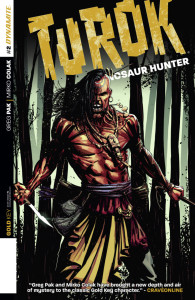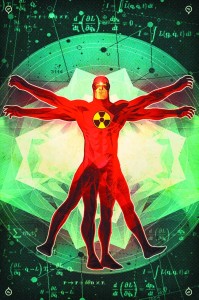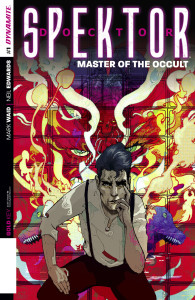I went into Dynamite’s Gold Key reboot with somewhat tempered expectations. I have no nostalgia for the characters; I didn’t read Valiant in the 1990s, and my attempts to explore the characters via Dark Horse reprints of the original stuff left me more bemused than anything (Really, those are some very stiff comics, albeit ones that have flashes of charm in their awkwardness).
Even so, it felt as if the reboot was hooked around the Valiant relaunch that has worked so well for me; the cover designs and logos—like those for Valiant, designed by the wonderful Rian Hughes—called to mind the Valiant look, and of the four books, two were written by Valiant writers. Plus, Nate Cosby was packaging and editing the line; if nothing else, I figured, it would be worth a look for his connection alone given other books he’s been involved with.
Overall, the line is not quite there yet, but not in a bad way. (The newest book is only two issues in, after all; it really is early days.) There isn’t a bad book amongst them, although they’re offering very different types of stories and may not necessarily hang together coherently in a universe just yet, unlike the Valiant relaunch which felt very streamlined from the very start.
 Taking them in order of publication, Turok: Dinosaur Hunter is arguably the most ambitious of the series, at least on the face of it—I suspect that Doctor Spektor is up to something far bigger, but we’ll get to that soon—and that ambition hurt the first four issues for me, with too much being thrown in to set up the status quo of the series but not enough “happening” to make it feel like it had a lot of momentum.
Taking them in order of publication, Turok: Dinosaur Hunter is arguably the most ambitious of the series, at least on the face of it—I suspect that Doctor Spektor is up to something far bigger, but we’ll get to that soon—and that ambition hurt the first four issues for me, with too much being thrown in to set up the status quo of the series but not enough “happening” to make it feel like it had a lot of momentum.
For those not following the book, it takes place in 1210AD, except that’s not quite true. Things are going weird with time, throwing the native American tribes that “belong” to the era into conflict with both prehistoric dinosaurs and religious crusaders from the middle ages (This may be a reference too obscure to mean anything to anyone, but it reminds me of the Joe R. Lansdale novel The Drive-In, which I loved many years ago). Greg Pak tries hard to not only unpack what that means for the various groups in his first storyline, but also give enough of an “origin story” to the title character, but the result is a bit muddied, with too many characters (and too few sympathetic ones) to really get a hold on.
The second storyline, which is currently midway through with #6, is far, far better, in large part because it strips the cast back considerably and allows for a clearer—and more character-led—conflict to emerge, with Turok’s dilemma being more sharply delineated. It helps, too, that Takeshi Miyazawa has taken over the art chores; original artist Mirko Colak is by no means a bad artist, but there’s something about Miyazawa’s work that makes the characters easier to relate to, and the book in general more organic and less forced.
Like Pak, Magnus: Robot Fighter boasts a Valiant veteran as writer: Fred Van Lente, who Jeff has a problem with on this book. While I understand his concerns, I don’t really share them, in part because I don’t think Van Lente really wants us to take this book as seriously as Jeff seems to believe he does (Naming a character H8R or spending two issues poking fun at the “political correctness”—I shuddered typing that without irony—modern audience awareness demands would suggest otherwise, for example) and in part because I appreciate Van Lente’s willingness to raise questions and concepts without signposting his own take on them.
What I’m less into, by the time we get to the series’ fifth and sixth (Sorry, fifth and “zero-th”) issues this week, the pace of the narrative, and the way it feels as if it’s getting away from me so early. I understand the need/desire to explore the broad Matrix-esque world of the series (High concept of the book: Magnus is awoken from virtual reality upbringing where man and machine live in perfect har-mon-ee as Michael Stevie and Paul once put it to a world where machines have replaced mankind as the dominant life form, for reasons that are not exactly what you might expect, goes on to fight robots and try to find the source of his VR childhood), but the book feels like it’s losing focus at the same time as Turok is coming into focus. Not necessarily a good thing, although it remains completely entertaining nonetheless.
(The art, by Cory Smith for the most part, is pleasingly blocky; it’s also one of those rare cases where a predominantly murky color palette from Marshall Dillon utterly fits, not least of which because it throws Magnus’ red-and-blue outfit into strong relief in almost every scene.)
 Having left behind the screwy past of Turok and the wacky maybe-future of Magnus, we reach Solar: Man of the Atom, which I really, really shouldn’t like as much as I do. It has a lot against it, whether it’s the sudden, jarring fill-in art midway through the third issue, the reliance on cartoon swearing (Sorry, but that always %@!*ing annoys me when I see it) or the oddly glacial pace of the story compared with the other series, and yet, I’m really fond of it.
Having left behind the screwy past of Turok and the wacky maybe-future of Magnus, we reach Solar: Man of the Atom, which I really, really shouldn’t like as much as I do. It has a lot against it, whether it’s the sudden, jarring fill-in art midway through the third issue, the reliance on cartoon swearing (Sorry, but that always %@!*ing annoys me when I see it) or the oddly glacial pace of the story compared with the other series, and yet, I’m really fond of it.
Much of that comes from Frank Barbiere’s tone for the book, which is at once pretentious—each issue starts with what’s essentially a text page featuring one line—and irreverent, matching the conflict within the title character, which Barbiere has reworked as essentially “What if Firestorm was Martin Stein and his pissed off daughter, whom he’d abandoned?” The bait and switch of essentially killing the title character of the book at the end of the first issue was something I appreciated, as well; a sign that all bets were off and that this wasn’t the Solar you knew.
The problem is that it’s not quite clear what this book is, just yet. It’s reminiscent of Ultimate Spider-Man (in a good way) as well as Firestorm, but it doesn’t quite have its own identity just yet. I’m sticking with it for now—there’s enough here to win the series a lot of goodwill, definitely—but this is a series that needs to find its own identity sooner rather than later. Ideally with one artist, instead of the five that illustrate the third issue.
And so, we arrive finally at Doctor Spektor: Master of the Occult, which is the most difficult of the series to get a handle on so far. Part of that is undoubtedly down to it being only two issues old, but there’s a sense of… misdirection, perhaps, about the series so far. The two issues so far have not only presented the eponymous lead as being one of the series’ many mysteries outside being one of writer Mark Waid’s trademark snarky leads, but have almost purposefully gone out of their way to keep what the book is about mysterious as well. Which leads me to wonder the following: Is Adam Spektor somehow the big bad of the Gold Key universe?
 We’ve definitely been given a strong hint or two in that direction—Magnus shows up in the second issue, saying that he came to save reality from Spektor, and there are some reality-bending (or, perhaps, multiple-reality-bending) elements in both issues to date that suggest that Spektor is easily manipulated, more powerful than he knows and more than likely, a bit of a sociopath. (Also, and this is something that is either an odd design decision or a clue, but Doctor Spektor is the only book where the logo isn’t placed at the same angle on the page, instead being “flat.” Although that might be a sign of me falling down the rabbit hole.)
We’ve definitely been given a strong hint or two in that direction—Magnus shows up in the second issue, saying that he came to save reality from Spektor, and there are some reality-bending (or, perhaps, multiple-reality-bending) elements in both issues to date that suggest that Spektor is easily manipulated, more powerful than he knows and more than likely, a bit of a sociopath. (Also, and this is something that is either an odd design decision or a clue, but Doctor Spektor is the only book where the logo isn’t placed at the same angle on the page, instead being “flat.” Although that might be a sign of me falling down the rabbit hole.)
To date, it’s a frustrating read, but intentionally so, I think; the problem with such stories, though, is that you can only throw questions at your audience for so long without them rebelling and demanding not only answers, but some concrete footing from which they can build a connection with the characters. If the dizziness of the opening issues isn’t grounded soon—whether with the “yeah, Adam is the problem” solution or something else that we can understand—then this might cross over from frustrating to annoying. Yet it is, still, early days. We’ll see how it shakes out.
Overall, the Gold Key line is “promising” more than “great,” but promising feels like a win these days, considering some of the alternatives out there. There’re definitely problems with each series, but all of them feel not only easily fixable, but close to being fixed, or the result of teething troubles that you can almost see being done away with within a couple of issues. It’s no Valiant—it’s not as slick, and not as coherent as a line—but that’s not necessarily a bad thing. File under “cautiously optimistic,” and ask me again in six months.


“Michael and Paul”??? You wouldn’t happen to be referring to Ebony & Ivory, would you? Double-check that reference. #Ijustcalledtosayyourewrong
I was and I am wrong. Or was wrong, because I’m going to edit to change it as soon as I finish this comment and then no-one will be any the wiser except I left this comment and oh God, it’s all gone wrong.
(I was thinking of “The Girl Is Mine,” appallingly. The only time Stevie even sounded like Michael was in that Scanty Sandwich sample, and that’s only because they sped him up. The shame.)
To the topic at hand, so far I’ve tried Spektor and Magnus, based solely on my like of the writers’ past work. Plus a *little* bit of nostalgia — never really got into 90’s Valiant, but I’m starved for a good book with some history. As a late-comer to the wonderful Modern Valiant reboot, I wanted to get in on this on the ground floor.
But a handful of books in, I think I might be done. They’re not bad. They’re just not exceptional. Sadly I’m trying to cut back on my buying (don’t want my wife to find my corpse buried under long-boxes) and there’s enough other great stuff out there that even Valiant may fall by the wayside for me.
I want either creator-owned work with a strong creative vision (cue Saga, Hellboy, Velvet, Sixth Gun, Stray Bullets, et al) or corporate properties that tickle my nerd bone (e.g., Daredevil, Mighty Avengers).
I hope the line does well, as competition strengthens the market and these are good creators I want to see dedicating their lives to making comics. But my patience and pocketbook just have too much competition :(
(Please please please don’t let “nerd bone” catch on as a phrase, Internet, PLEASE….)
The fact that you can take an entire line of Dynamite books and file it under “cautiously optimistic” is a big improvement for the publisher and for comics in general. And! based on the covers I wouldn’t be embarrassed to read any of these in public. The publisher’s name used to be a red flag for me but now it’s like I don’t even notice it’s there on the front.
Just the fact that we’re reading & discussing yet another Gold Key relaunch is a pretty great success. I don’t remember *anyone* talking about Dark Horse’s attempt a few years ago.
@graemem, did you read any of the 2010 Dark Horse series? I don’t even remember the creative teams. Why do you suppose this attempt is promising, while that attempt failed miserably?
The Creators?
The Market?
Quality of the Books?
Better Hype / Press?
All of the above?
“Things are going weird with time, throwing the native American tribes that “belong” to the era into conflict with both prehistoric dinosaurs and religious crusaders from the middle ages”
Wait, if it’s 1410 AD, isn’t it already in the Middle Ages? Or do you mean it’s only the dinosaurs that are “out” of time?
Er, 1210, I meant to write. Isn’t 1210 Middle Ages?